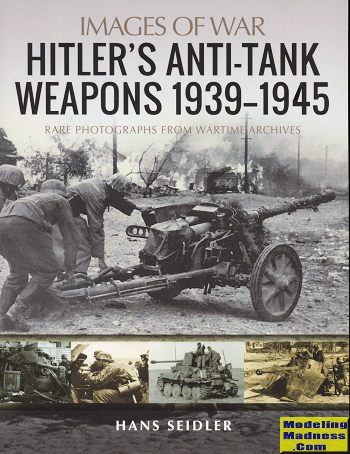 This
addition to the Images of War series concentrates on German anti-tank weapons.
At the start of the war, the calibre of these weapons was fairly modest as most
tanks of the time were not thickly armored. There were exceptions, but they were
fairly minimal in number. For that reason, anti-tank rifles and the 37mm gun
were usually sufficient for most purposes.
This
addition to the Images of War series concentrates on German anti-tank weapons.
At the start of the war, the calibre of these weapons was fairly modest as most
tanks of the time were not thickly armored. There were exceptions, but they were
fairly minimal in number. For that reason, anti-tank rifles and the 37mm gun
were usually sufficient for most purposes.
However, as the war continued, these weapons became
in-effective. This was discovered during the invasion of the Soviet Union when
German forces came upon the KV series of tanks and the T-34. Here were tanks
that needed more punch to put out of action. This back and forth between gun
calibre and armor continued throughout the war.
As time went on, obsolete and captured tank chassis were
used to provide the basis for a number of different mobile anti-tank guns. These
were generally referred to as Panzerjaegers. They had some fairly thin armor
shields to protect the crew from rifle fire, but their main benefit was that
they could quickly be moved to another location as needed. With the towed guns
increasing in size so did the weight and it was not unusual later in the war for
the positions to be over run befor the guns could be moved.
The Panzerjaegers came in a bewildering number of
vehicles and one of the big bonuses of a book like this is that it helps to
separate them out. In addition, some of these guns were put on half tracks,
providing even more mobile platforms. These would be like the US GMC (gun motor
carriage), though not that many were actually converted.
The final type was the panzerfaust and panzerschreck.
The former is the father of all RPGs and was a hand held, soldier-operated
single shot weapon that was very effective at close range. The panzerschreck was
not so widely used, and was basically an upsized bazooka. These last two items
were very widely used in the last year of the war.
In line with other titles in this series, the author has divided the book into several sections,
each covering a certain part of the war. It starts with what was available to
the army in 1939 and continues up until the last year of the war in Europe. As
usual, this is a photo book so each section has an introductory history followed
by a superb selection of period photos covering the vehicles and equipment of
the period. This is an excellent offering for the modeler and a good primer for
those who are looking for a one stop book on the subject.
This is another excellent addition to a fine series and
one that I can easily recommend to both the historian and modeler alike.
June 2020
Copyright ModelingMadness.com. All rights reserved.
Review book courtesy of
Casemate Publishing, where you can order your copy
at this link.
If you would like your product reviewed fairly and
fairly quickly, please
contact
me or see other details in the
Note to
Contributors.
 This
addition to the Images of War series concentrates on German anti-tank weapons.
At the start of the war, the calibre of these weapons was fairly modest as most
tanks of the time were not thickly armored. There were exceptions, but they were
fairly minimal in number. For that reason, anti-tank rifles and the 37mm gun
were usually sufficient for most purposes.
This
addition to the Images of War series concentrates on German anti-tank weapons.
At the start of the war, the calibre of these weapons was fairly modest as most
tanks of the time were not thickly armored. There were exceptions, but they were
fairly minimal in number. For that reason, anti-tank rifles and the 37mm gun
were usually sufficient for most purposes.